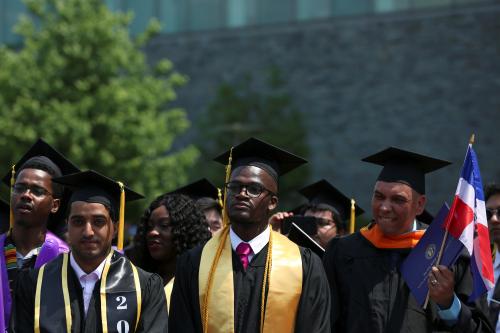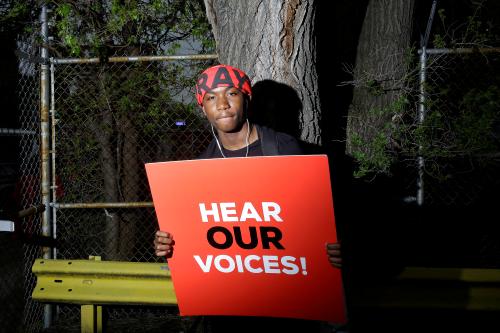The Brown Center Chalkboard has recently featured many articles on racial issues in education. Though empirical evidence and policy considerations are rightfully part of these discussions, we feel it is valuable to spotlight the personal side of racial inequities in education as well. The following piece is an example of the latter angle.
“Don’t dream too big.”
This was a subtle and overt message sent to students of color in the America of our childhood. Decades later, has it really changed?
Our shared experience as low-income students of color struggling for equality a mere 40 or 50 years ago is just as relevant today: A poor black girl raised in the Jim Crow South by a single mother who wasn’t thought to have a chance; a Puerto Rican boy from a low-income Spanish-speaking household who seemed destined for vocational work with just a high school diploma.
Neither of us was expected to go very far. In fact, there were systemic barriers in place to prevent academic achievement. The message at every step: “You don’t belong here.”
We ignored and defied those messages and barriers, both of us going on to achieve a series of firsts in our families, culminating in doctoral degrees. Both of us marched forward, alongside many of our generation, determined to clear the path to educational opportunity and attainment for the next generations of young people. We have dedicated our professional lives to that work, one of us primarily in P-12 education, and the other focusing on equity in higher education. And we, as a nation, have made good progress.
But you’d think that more than half a century after Brown v. Board of Education, there would be even greater progress. After all, we live in a more diverse country than ever before, and America is projected to become even more racially and ethnically diverse. By 2025, students of color are expected to make up the majority of high school graduates. Yet currently, more than 80 percent of the teaching force is white, and 40 percent of schools have no teachers of color at all (according to a 2011 report), depriving all students of the benefits of learning from diverse educators.
Moreover, as we look at the actions of the current administration and gaze out over a country racked by racial injustice and rhetorical division, we worry that if change travels at the same sluggish speed—backwards, even—today’s students will have to face many of the still-standing barriers and injustices that we had to surmount so many years ago. Right now, students of color, their families and their communities, our schools and our universities, and our very democratic values are under attack. And students are feeling this both inside and outside the school doors.
Just in recent months, white supremacists have marched on college campuses spewing hate and inciting violence. Undocumented immigrants worry whether they are safe at school, or whether their parents will be deported while they’re in class. Children and young adults of color are receiving the message loud and clear: You don’t belong. And we fear, given the actions of this current administration, that things will only get worse.
Just as America needs to be investing more to close gaps in educational funding equity P-12, Congress is hiding behind its self-imposed budget caps, which “prevent” them from appropriately funding the programs that will make a difference for students.
Just as America needs to be equipping teachers with increased skills and knowledge to teach all students to new rigorous college preparatory standards, the administration proposed gutting Title II of the Elementary and Secondary Education Act. This essential measure supports teacher training and gives critical support to educators in schools serving concentrations of low-income students and students of color who too often get the least well-prepared teachers.
And just as America needs to be getting more students to and through college, Congress and the administration are working against that goal. Congress, for example, wants to raid Pell Grant funding, which helps more than 7.5 million students attend and complete college. And the administration has attacked DACA, putting the futures of 800,000 children and young adults, many of them students, at risk.
The administration is also moving to thwart affirmative action. There’s a perception that African-American and Latino students are somehow taking spots that qualified white students should have access and are entitled to. But the data show otherwise: Only 5 percent of students enrolled at public flagship institutions are black, and less than 9 percent are Latino, compared with 63 percent of white students.
So although we all now drink from the same water fountains, children of color still go thirsty for the education they need and deserve. In an America plentiful with opportunity and resources, no child’s well should run dry, no child’s potential should go undernourished, and no child should be told to do anything less than dream big.
Just like that little Southern black girl and that Puerto Rican boy from L.A., students of color and low-income students need access and opportunity. School shouldn’t be something students survive—like we did—but an environment where they are given an opportunity to thrive.






Commentary
American students need to be able to dream big
November 16, 2017